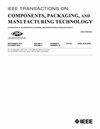基于相变材料的混合散热器在电子冷却应用中的研究
IF 2.3
3区 工程技术
Q2 ENGINEERING, ELECTRICAL & ELECTRONIC
IEEE Transactions on Components, Packaging and Manufacturing Technology
Pub Date : 2024-08-30
DOI:10.1109/TCPMT.2024.3452484
引用次数: 0
摘要
通过瞬态三维数值研究评估了基于相变材料 (PCM) 的混合散热器的性能。PCM 采用被动冷却方式散热,而液体流经微通道时则采用主动冷却方式分解 PCM。被动和主动冷却模式在不同的工作温度下周期性地运行。在雷诺数(Re = 497、995、1492)和供应热通量(q'' = 50、100、150 kW/m2)范围内,通过改变微通道的长宽比(AR)(AR = 1 和 3)和翅片间距/PCM 体积($S = 1$ 、2、4)进行模拟。记录并详细分析了所有研究案例的结温、PCM 液体分数和能耗的瞬态变化。目的是确定导致主动冷却时间少于被动冷却时间的参数。数值结果表明,被动-主动-被动冷却导致的周期性温度变化的频率和振幅是雷诺数、热通量、PCM 体积和微通道 AR 的函数。主动冷却时间和分解的 PCM 量与雷诺数成反比变化。此外,还观察到 AR 的增加对改善基于 PCM 的混合散热器的性能具有有利影响。在本文研究的参数范围内,观察到如果使用 AR 值为 3 的微通道,混合散热器的能耗比 AR 值为 1 的微通道低约 22%-89%。 PCM 的数量对混合散热器的性能起着至关重要的作用;因此,1 毫米的鳍间距比 2 毫米和 4 毫米的鳍间距效果更好。所提出的混合散热器概念将有助于减少微型电子设备对主动冷却系统的依赖。本文章由计算机程序翻译,如有差异,请以英文原文为准。
Study of Phase Change Material-Based Hybrid Heat Sink for Electronics Cooling Application
The performance of a phase change material (PCM)-based hybrid heat sink is evaluated using a transient, 3-D numerical study. PCM is used in a passive cooling method to dissipate the heat, whereas liquid flowthrough microchannels is employed as active cooling to resolidify the PCM. Passive and active cooling modes operate periodically, governed by various operating temperatures. Simulations are performed by varying aspect ratio (AR) of the microchannel (AR = 1 and 3) and fin spacing/PCM volume (
$S = 1$
, 2, 4) for the range of Reynolds number (Re = 497, 995, 1492) and supplied heat flux (
$q'' = 50$
, 100, 150 kW/m2). Transient variations of junction temperature, PCM liquid fraction, and energy consumption are recorded and analyzed in detail for all the cases studied. The objective is to identify the parameters leading to less active cooling time than passive cooling. The numerical results show that the frequency and amplitude of periodic temperature variation owing to passive-active–passive cooling are a function of Reynolds number, heat flux, PCM volume, and AR of microchannels. The time of active cooling and the quantity of resolidified PCM vary inversely with the Reynolds number. Furthermore, an increase in AR was observed to have a favorable effect on improving the performance of PCM-based hybrid heat sink. For the range of parameters studied in this work, it is observed that around 22%–89% less energy is consumed by a hybrid heat sink if a microchannel of AR 3 is used compared to that of 1. The quantity of PCM plays a vital role in the performance of hybrid heat sinks; therefore, a fin spacing of 1 mm works better than that of 2 and 4 mm. The proposed concept of a hybrid heat sink will help reduce the dependency on an active cooling system for miniaturized electronic devices.
求助全文
通过发布文献求助,成功后即可免费获取论文全文。
去求助
来源期刊

IEEE Transactions on Components, Packaging and Manufacturing Technology
ENGINEERING, MANUFACTURING-ENGINEERING, ELECTRICAL & ELECTRONIC
CiteScore
4.70
自引率
13.60%
发文量
203
审稿时长
3 months
期刊介绍:
IEEE Transactions on Components, Packaging, and Manufacturing Technology publishes research and application articles on modeling, design, building blocks, technical infrastructure, and analysis underpinning electronic, photonic and MEMS packaging, in addition to new developments in passive components, electrical contacts and connectors, thermal management, and device reliability; as well as the manufacture of electronics parts and assemblies, with broad coverage of design, factory modeling, assembly methods, quality, product robustness, and design-for-environment.
 求助内容:
求助内容: 应助结果提醒方式:
应助结果提醒方式:


